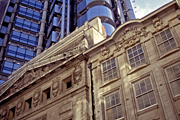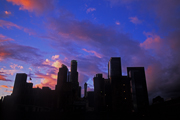Adventures in Art, Photography & Design
PHOTO | GRAPHIC | IMAGE | ARTS
Five unstructured and unrepentant ruminations on art, vision, signs, symbols, graphic depiction and photographic imagery.
OPTICAL DELUSIONS
What is the relationship between imagery, graphics, graphic images derived from photography and photographic images—in the context of fine art, decorative arts and communication arts?
The advent of photography has had, and continues to have, a profound impact on the development and evolution of fine art and graphic images, including symbols, icons and corporate logos.
Human beings have been creating graphics since the dawn of time. The paleolithic painted images of animals found in the caves at Lascaux (estimated to be 20,000 years old) , are often cited as an example of early graphic imagery. The paintings at Lascaux are amazingly naturalistic and beautiful. However, Lascaux is an ancient ritual site and it's images were used for some sort of spiritual rites and magical invocation. The graphic depiction of animals was most likely a way of attempting to control the environment by invoking the animal spirits—perhaps to attract them for the hunt, to communicate with their spirit powers, or to assure that the migratory patterns of the animals depicted remained predictable. They were certainly not made as a means to facilitate communication between human beings. In fact, the means of access to the caves, starting with their hidden entrance, and the narrow, nearly vertical access shafts, ("terrifying", according to Jacques Marsal, one of the discoverers of the caves), are so daunting, it is clear that most humans were not welcome in the caves. These truly "underground" images, beautiful as they are, have nothing to do with graphic design as we know it.
However, contemporary graphics also have something to do with controlling the environment— for example, logos and trademarks represent corporate brands, and brands are all about the attempt to control perception, (think BP's "sun/flower" logo before the Deepwater Horizon disaster, or ValueJet's ownership, logo and name change to AirTran Airways following their Everglades disaster). However, they are also meant to be propagated from human to human, usually via widespread media distribution, based on mechanical, electronic, or today, digital, reproduction. They are designed to be reproducible.
Symbols are a special sub-set of graphics: used to communicate specific meanings within the context of a particular culture. However, over the mountains, or across the river, the same symbol could mean something entirely different. Meaning is malleable. Like languages, symbolic communication is based upon local and regional agreements that evolve and transmute over time.
Compared with graphics, which have been in use, and evolving, for millennia, photography is a very recent development, photographic images having made their first, sudden appearance on the scene in the latter half of the 19th century.
Are All Images Photographic Images?
On the surface, this seems like a reasonable question. After all, many of the images we visualize—say, the skyline of a city we have never visited, the face of a famous celebrity, a product we've seen in an advertisement—we visualize and experience as "photographic images". As our primary mode of experiencing these things, the photographic image may, in fact, be the only "existence" these things have for us. They are things that have been photographed, or, at least, could be photographed. If one can see it, one can photograph it, no?
The act of photographing something, and then externalizing the image, (via print, digital representation or other means), makes the original subject seem more real, or to be more precise, literally gives it more presence in the realm of perceived reality. It gives the photographed subject an alternative reality, a secondary reality in addition to the subject's "real" reality—the reality that we can directly touch, smell or otherwise experience through our senses. But is anything really directly experienced?
Multiple photographs augment and enhance a "real something" with multiple realities. More realities make something more real, no? More real than real. Is that possible?
Why do people cry when celebrities they have never met die? Is it because they have seen hundreds of images of this person, (or thousands, in the case of film or television, where one is exposed to 24 or 30 images per second, respectively), and therefore feel as if they actually "know" this person? A reality that may be real to someone, somewhere, but not to the viewer, becomes real by the mechanism of repetition, until, in some cases, the virtual reality of the image becomes more real than the viewer's actual reality.
Is it possible that some who cried at the news of the death of Elvis, or President Kennedy, or John Lennon, or Michael Jackson, did not cry when their own mother or father died?
A celebrity is exposed to film, or digital sensors, but we are exposed to images of celebrities. Enough exposure creates an emotional exposure, a vulnerability that we normally would not experience unless we knew a person in real life as an individual. This exposure, and its associated vulnerability is asymmetric: you may feel like you know the celebrity, but the celebrity doesn't know you. Millions of fans willingly "give themselves over" to this asymmetric vulnerability in their real lives. But what is "real life" in the 21st Century? Our lives are massively mediated by media. Our imaginations are largely imagined for us by teams of professional "visioneers" and "image makers". When we recall, relate or re-enact a favorite scene from a movie, we participate in this process by imagining what was pre-imagined, (i.e., "imaged"), for us, so that we could experience it, visually, in the first place. We see images, but more importantly, we experience images and actively participate in recreating the experience of those images when recalling them.
Visual artists create images that we can see, (i.e., externalize them), and by seeing, we participate in recreating that image, again, inside our minds. Creation, re-creation. Image, sight, image. Imagination to imagination. Mind-to-mind transmission. Visualizing artists who make images share the experience of their original vision. Images, like songs and stories, operate like viruses. They enter our minds and take root there. They live inside us. When externalized they can be transmitted. The virus-like meta-behavior of visual images, symbols, music, stories and more, are the root of what we call culture. (By "meta-behavior", I mean that the images, songs, etc., themselves do not "behave"—rather their seemingly life-like and self-propagating behavior is a result of how our minds process and work with images.)
Did images as we know them exist prior to the photographic process? Does visualization always involve imagery? Is a painting of a rabbit a painting, or an image... or a rabbit? What is the relationship between image and representation in art? Can an object be represented without a visual image? Can a visual image be represented as an object? Is a graphic image derived from a photograph a photographic image? Do photographic images require the photographic process? Are digital images really photographic images? Is video rooted in photography? Is digital video really video? Do photographs require light to exist? Do photographic images require light to exist? Do images visualized in one's mind require light to exist?
Do images exist?
Contrast Control
To answer the last question, let's start by thinking about what an image isn't: Images are not flat swatches of color. If one looks at a computer monitor that is displaying solid black, or solid white or any other solid color across the entire screen, we would say that there is no image there, correct? But is that true?
Anyone that's ever done any image manipulation knows that it's possible to add "white" to an image in order to "tint" it, and add black to an image in order to "shade" it. In the design profession, both are referred to a "ghosting" an image, methods to make an image appear subtle.
Tinting the values in an image toward white or shading the values toward black both reduce the contrast within the image. Take the contrast of an image down to zero, and the "image" appears to completely disappear. One is left with a flat color swatch. In a digital image, if every pixel in an image is set to display the same color, the data from the original image may still be there, but the image can no longer be percieved by the human eye (or an non-human eye, for that matter). The resulting flat swatch may be any color and any value, but there is no (perceivable) image. Where did it go? So, here's an interesting thing about images: in order to be visible, images require both hue and value information, (including black and white photographs). But they also require contrast. No contrast, no image.
Of course, images have something to do with seeing, but seeing itself is not imagery. As we will explore later, it is possible to see without seeing an image.
If we have a framed photograph on the wall of a room without windows, and turn the lights out, is the image still there? Mentally, we may "know" that the image is still there—just unilluminated. However, if we cannot see the image, and neither could anyone else, for all practical purposes, the image no longer exists.
Or does it?
Imagine scratching an image onto the surface of piece of marble, then covering the marble with a sheet of plywood glued to its surface. We would no longer be able to see the image. Yet, if we X-rayed the wood covered marble, we would see the image under the wood. Are we seeing the scratches in the marble and interpret the scratches as an image, or is there simply an image there? It appears that "images" can "exist" even if they cannot be apprehended by the human eye under standard, visible light.
There are many ways of rendering an image... via paint on canvas, scratches on the surface of a metal plate, (etching), carving into the surface of a block of wood, coating the surface with ink and transferring that ink to a sheet of paper, (woodblock printing), applying ink, and charcoal of graphite directly to sheet of paper or other surface, (drawing).
But when do scratches on a surface become an image, and when are they just scratches? When we "read" scratches, gouges, or even constructed physical forms such as charcoal on paper as "images", we are projecting meaning onto those physical marks. Images, like graphics, are vessels that we fill with meaning and identity. Some scratches may appear to form an image, but fundamentally, all scratches are just scratches.
Thus, we can think of imaging processes like x-rays, magnetic resonance imaging, airport full-body scanners and similar tools as technologies that make the invisible visible by producing images of hidden physical structures. In other words, they don't "reveal" images, they create images from physical forms that are blocked from view by other physical forms.
Of the many processes for rendering an image, film and prints made from phostographic images are tentative and fragile. When exposed to sunlight, over time, they lose their contrast. The images they hold are prone to disappearing. They fade, like old memories.
Persistence vs. Existence
Some speak of photography as "capturing a moment in time". Even though, on it's surface, this sounds like a downright facile description of photography, it accurately describes one profound aspect of photography. Through the photographic image, moments in real life that would otherwise be fleeting and transitory—literally hard to "see"—appear to persist, indefinitely, in a state of observational grace. The very persistence of that moment, say, of a dog flying in mid-air about to catch a thrown ball... gives photographs an otherworldly presence. There doesn't even have to be a subject in motion: even a motionless portrait of a pepper by Edward Weston can embody the presence of a hyper-real, suspended moment in time.
Today, we cannot fully appreciate the stunning impact on viewers of that age, seeing those first photographic images by Eadweard Muybridge of a horse mid-gallop, all four feet off of the ground... forever levitated in that gravity-defying state of being. Motion pictures had not been experienced yet, so there was no categorical concept of "film still" or "freeze frame". Those first images of frozen floating horses must have seemed absolutely magical.
The persistence of this frozen moment of time takes on its own existence in the form of the photographic print. The image, captured by a mechanism of light, optics, film (or digital CCD/CMOS sensor) is brought to life in the real world by the secondary process of externalization. Manifesting the image, (by photochemical print; by projection; by digitally printing the image onto a substrate; or by displaying the image on a digital monitor), allows the image itself to be shared, (i.e., transmitted into the minds and committed to the memories of others).
Is an image that is merely stored as digital data on a drive, and never manifested visually, an image? No, it is only data arranged and written onto storage media. This begs the question: if any form of visual imagery can be digitally stored as numeric data, can any form of data be rendered as visual imagery? Yes. Data that did not start out as a mathematical representation of an image may be displayed using arbitrary or systematic rules to create innumerable varieties colorful or grayscale patterns. These patterns may not appear to be "recognizable visual imagery" when externalized, in that they cannot be correlated with "objects" and "spaces" in one's normal and historic visual field, but may appear to be random, if colorful, "patterns". Of course, patterns are also a form of visual imagery.
This also means that data that did start out as a mathematical representation of an image also may be displayed using arbitrary or systematic rules to create innumerable varieties of patterns, including "recognizable" images. Space imagery from NASA or JPL are good examples of this. There is no "correct" way to display any given image, unless one's intent is to visually recreate a specific object or objects in a specific environment with specific lighting conditions. This would include artists wishing to "reproduce" a painting as a print, representing the colors in the original painting accurately. Of course, every mechanical, photographic and digital form of image representation has it's limitations in terms of the color range (gamut) that can be accurately reproduced... thus "color accuracy" in image reproduction, today, is still a relative target.
Tomorrow may be different.
When an image is successfully transmitted into another's mind, and committed to memory, new synaptic pathways are created in the recipient's brain. The recipient's brain is literally being restructured, (albeit in a minor way, proportional to all of the cellular activity and synaptic connections present in the brain). Regardless, image transmission and acquisition is a fundamentally a form of physical brain manipulation.
That sounds a bit ominous, but anything committed to memory, (i.e., music, flavors, sensations, emotions, and so on), works in the same way. This is the way our neural networks operate. One's brain is in a constant state of evolution and devolution, (in the case of aging and memory loss).
We will eventually arrive at the point where it will be possible to accurately map the synaptic brain patterns associated with visualizing a particular image and directly stimulate the same electro-chemical patterns in another's brain... thus delivering a truly accurate baseline for visual representation of the original image.
Seen, Yet Not Seen
When that point comes, we will be addressing, finally, the core nature of images: "Images" do not exist in the real world. Images only exist in our minds. Even if fed identical impulses through our nervous systems, every mind will receive, parse the incoming impulse patterns, distribute and analyze those patterns, then finally synthesize, (i.e., perceive) an image that is particular to that individual. Even starting with identical electro-chemical patterns, the image that is "seen" will be experienced differently by every person. This is the inherent mystery that lies at the heart of image perception. Images are not things, they are experiences.
That pattern is received through our visual sensory apparatus (eye, retina, optic nerve, etc.) and distributed as electrical impulses and chemical signals to various parts of the brain. The brain itself parses the enormous quantity of information arriving through the optic nerves and magically creates the "image". I say magically, because we do not yet clearly understand the mechanism for this amazing transformation. Thus, when we say we "see" an image, "with our own eyes", we are not seeing it with our eyes, we are seeing it with our mind.
For example, when we gaze upon a photographic print or a computer monitor, what our eyes and associated visual sensory apparatus are taking in are a pattern of colors arranged through a range of light and dark values arrayed across a surface. The paper, (and the computer, for that matter), does not know, and does not care, what that pattern "represents", "means", or "is".. Only people do.
The phrase "The Minds Eye" refers to our imagination, the ability to internally generate sensory "events", (visual, auditory, tactile, kinesthetic, and so on). However, this phrase also accurately describes the actual process of simply "seeing" the world around us.
Pictures at an Exhibition
When Mussgorsky composed his piano suite, Pictures at an Exhibition, photography was still in its very early stages and computers and digital media did not yet exist.
Pictures at an Exhibition is a musical evocation of a visual and emotional experience: moving through an art exhibition and looking closely at each work.
When viewing "pictures", (today a quaint way of referring to both photographs and paintings, particularly historic, representational paintings), in a gallery, one can see many of the pictures in the room at once, in the 3-dimensional space we discussed earlier. One also walks past and engages in individual pictures, one at a time. This "walking past" is referred to by Mussgorsky as the Promenade, and his theme for it is very well known.
It is interesting to "promenade" through an art gallery while listing to Pictures at an Exhibition through your earbuds. It is ideal if the "gallery" is an historical one, architecturally weighty, such as the Metropolitan Museum of Art, in New York City. but any good museum or gallery will do. In fact, it is quite fun to do this in a museum filled with 20th-century modern art, like the Museum of Modern Art, particularly abstract paintings. The music, at times, is dark and dramatic, and at points will have you chuckling softly at the ironic juxtaposition of the music and the paintings.
What does this have to do with imagery?
Imagery can be evoked through the other senses, in this case aurally, via music. Every composer I know looks at images while producing music. Every artist I know listens to music while making visual art. Can images, (and memories), be evoked through taste... or smell? This was the basis for the famous madeleine cake episode in Marcel Proust's novel, Remembrance of Things Past: one kind of sensory experience can trigger other kinds of sensory and emotional experiences, in particular, vivid memories of those experiences.
Vision and memory are closely intertwined. The memories of some visual images never fade. However, many, including the faces of ones that we loved, fade over time. much to our frustration.
It is an interesting exercise to enter a quiet space, and think back on specific moments or events in one's life, and spend some time trying to recall, in as much visual detail as possible what you were seeing, what things looked like at that moment. My earliest memories, which are primarily visual, (no surprises, since I was not yet able to speak much), extend back to before I was one year old. Many of those visual images are very, very vivid. In fact, everything I could see was very vivid, most likely because I had never seen these things before, (such as our street lined with maple trees, the sunlight shimmering off of every quivering leaf), but also possibly because of the mundane reason that my vision was so much better then.
As an artist who has had to wear glasses since the fourth grade, and who has been plagued with rapidly degrading vision throughout my teen years, vision is very important to me. Since elementary school, I have been developing strategies and unusual tactics to see more than my poor vision would ordinarily allow. This is an entirely different topic, but it is worth noting that many people who have been driven to overcome obstacles in life end up with heightened abilities in other areas. I have been told that I am a good listener, in the usual sense of the phrase, but also have developed a keen sensitivity and sensibility to music and sound.
.....................






